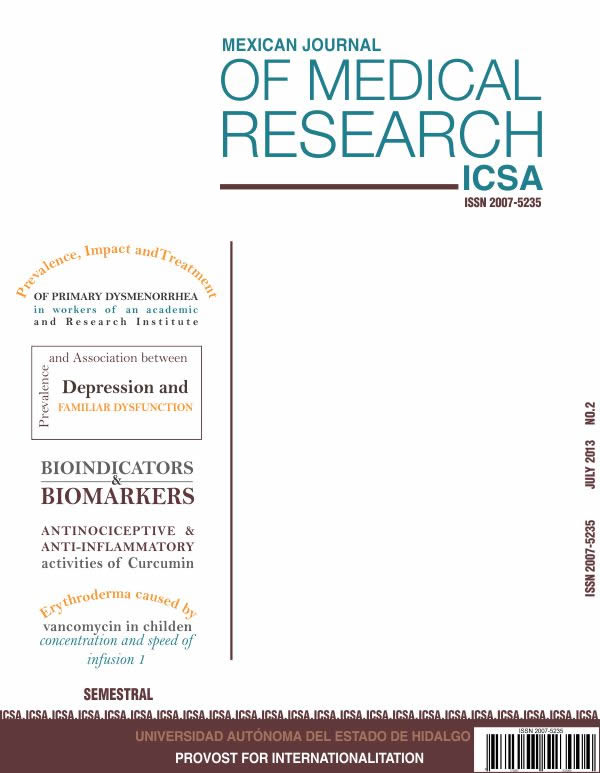Prevalence, impact and treatment of primary dysmenorrhea in workers of an Academic and Research Institute
Abstract
Dysmenorrhea is one of the cyclical processes in chronic pelvic pain. Dysmenorrhea in women causes a high psychosocial and economic impact. For this reason, we conducted a study to assess the prevalence, impact and use of drugs for the treatment of dysmenorrhea among workers of an Educational and Research Institute. A prevalence of dysmenorrhea of 57.2% was found. About a half (49.4%) of women with dysmenorrhea reported that it limited their daily activities in 4.1 ± 2.4 cycles per year. 29.3% reported absenteeism by at least 2.7 ± 1.4 (range 1-5) cycles per year. Of the women with dysmenorrhea, only 34.9% consulted a doctor and the most prescribed drugs were over the counter medications with metamizol and butylscopolamine (25.0%), another medicine with paracetamol, pamabrom and pyrilamine (Syncol®, 16.7%) naproxen (12.5%) and mefenamic acid (12.5%). On the other hand, self-medication was practiced by 54.2% of women with dysmenorrhea and the most used drugs were Syncol® (28.9%), naproxen (17.8%), metamizol with butylscopolamine (13.3%) and dipyrone (6.7%). Our data suggest a significant prevalence of primary dysmenorrhea and dysmenorrheic women used many drugs for self-medication, but rarely come to medical services.
Downloads
References
2 Chan WY, Dawood MY. Prostaglandin levels in menstrual fluid of nondysmenorrheic and of dysmenorrheic subjects with and without oral contraceptive or ibuprofen therapy. Adv. Prostaglandin Thromboxane Leukot. Res. 1980; 8: 1443–7.
3 Sales KJ, Jabbour HN. Cyclooxygenase enzymes and prostaglandins in pathology of the endometrium. Reproduction 2003; 126:559–67.
4 Dawood MY. Dysmenorrhea. J. Reprod. Med. 1985; 30: 154–67.
5 Andersch B, Milsom I. An epidemiologic study of young women with dysmenorrhea. Am. J. Obstet. Gynecol. 1982; 144: 655–60.
6Jamieson DJ, Steeg JF. The prevalence of dysmenorrhea, dyspareunia, pelvic pain, and irritable bowel syndrome in primary care practices. Obstet. Gynecol. 1996; 87: 55–8.
7 Ortiz MI. Primary dysmenorrhea among Mexican university students: prevalence, impact and treatment. Eur. J. Obstet. Gynecol. Reprod. Biol. 2010; 152: 73–7.
8 Larroy CM, Crespo M, Meseguer C. Dismenorrea funcional en la Comunidad Autónoma de Madrid: estudio de la prevalencia en función de la edad. Rev. Soc. Españ. Dolor, 2001; 8:11–22.
9 Teperi J, Rimpela M. Menstrual pain, health and behaviour in girls. Soc. Sci. Med. 1989; 29: 163–9.
10 Sundell G, Milson I, Andersch B. Factors influencing the prevalence and severity of dysmenorrhea in young women. Br. J. Obstet. Gynaecol. 1990;97: 588–94.
11 Pedrón-Nuevo N, González-Unzaga LN, De Celis-Carrillo R, Reynoso-Isla M, de la Torre-Romeral L. Incidence of dysmenorrhea and associated symptoms in women aged 12-24 years. Ginecol. Obstet. Méx. 1998: 66: 492–4.
12Pawlowski B. Prevalence of menstrual pain in relation to the reproductive life history of women from the Mayan rural community. Ann. Hum. Biol. 2004;31:1–8.
13 Velasco-Rodríguez R, Mora-Brambila AB, González-Ortega LE, Bonilla-Gutiérrez OJ. Características clínicas y tratamiento de dismenorrea en estudiantes de licenciatura en enfermería. Rev. Enferm. IMSS. 2006; 14: 29–34.
14 Dawood MY. Nonsteroidal anti-inflammatory drugs and changing attitudes toward dysmenorrhea. Am. J. Med. 1988; 84: 23–9.
15 Bergsjo P. Socioeconomic implications of dysmenorrhea. Acta Obstet. Gynecol. Scand. Suppl. 1979; 87: 67–8.
16 Johnson J. Level of knowledge among adolescent girls regarding effective treatment for dysmenorrheal. J. Adolesc. Health Care. 1988; 9: 398–402.
17 Burnett MA, Antao V, Black A, Feldman K, Grenville A, Lea R, Lefebvre G, Pinsonneault O, Robert M. Prevalence of primary dysmenorrhea in Canada. J. Obstet. Gynaecol. Can. 2005; 27:765–70.
18 Hillen TI, Grbavac SL, Johnston PJ, Straton JA, Keogh JM. Primary dysmenorrhea in young Western Australian women: prevalence, impact, and knowledge of treatment. J. Adolesc. Health. 1999; 25: 40–5.
19 Vicdan K, Kukner S, Dabakoglu T, Ergin T, Keles G, Gokmen O. Demographic and epidemiologic features of female adolescents in Turkey. J. Adolesc. Health. 1996; 18: 54–8.
20 Widholm O. Dysmenorrhea during adolescente. Acta Obstet. Gynecol. Scand. Suppl. 1979; 87: 61–6.
21 Klein JR, Litt IF. Epidemiology of adolescent dysmenorrhea. Pediatric 19841; 68: 661–4.
22 French L. Dysmenorrhea. Am. Fam. Physician 2005; 71: 285–91.
23 Connolly TP. Cyclooxygenase-2 inhibitors in gynecologic practice. Clin. Med. Res. 2003; 1:105–10.
24Bitner M, Kattenhorn J, Hatfield C, Gao J, Kellstein D. Efficacy and tolerability of lumiracoxib in the treatment of primary dysmenorrhoea. Int. J. Clin. Pract. 2004; 58: 340–5.
25 Reddish S. Dysmenorrhoea. Aust. Fam. Physician 2006; 35:842–9.
26 Juhasz AG, Vincze G, Krasznai Z, Csorba R, Major T. Dysmenorrhea in adolescent girls. Orvosi. Hetilap. 2005; 146: 27–32.
27 Campbell MA, McGrath PJ. Use of medication by adolescents for the management of menstrual discomfort. Arch. Pediatr. Adolesc. Med. 1997; 151:905–13.
28 Fraser IS. Prostaglandins, prostaglandin inhibitors and their roles in gynaecological disorders. Baillieres Clin. Obstet. Gynaecol. 1992; 6:829–57.
29 Zhang WY, Li Wan Po A. Efficacy of minor analgesics in primary dysmenorrhoea: a systematic review. Br. J. Obstet. Gynaecol. 1998; 105:780–9.
30 Dawood MY, Khan-Dawood FS. Clinical efficacy and differential inhibition of menstrual fluid prostaglandin F2alpha in a randomized, double-blind, crossover
31 treatment with placebo, acetaminophen, and ibuprofen in primary dysmenorrhea. Am. J. Obstet. Gynecol. 2007; 196: 35.e1–35.e5.
32 Girolamo G, Sánchez AJ, De los Santos AR, González CD. Is acetaminophen, and its combination with pamabrom, an effective therapeutic option in primary dysmenorrhoea?. Expert Opin. Pharmacother. 2004; 5:561–70.
33 Hackenthal E. Paracetamol and metamizol in the treatment of chronic pain syndromes. Schmerz. 1997; 11: 269–75.
34 Ortiz MI, Rangel-Flores E, Carrillo-Alarcón LC, Veras-Godoy HA. Prevalence and impact of primary dysmenorrhea among Mexican high school students. Int. J. Gynaecol. Obstet. 2009; 107: 240–3.
35 Ortiz MI, Nuri Pérez-Hernández, Arturo Macías, Eduardo Rangel-Flores, Eduardo Fernández-Martínez y Héctor Ponce-Monter. Utilización de Fármacos Para el Tratamiento de Dismenorrea Primaria en Estudiantes Universitarias. Rev. Mex. Cienc. Farmac. 2007; 38: 24–9.













